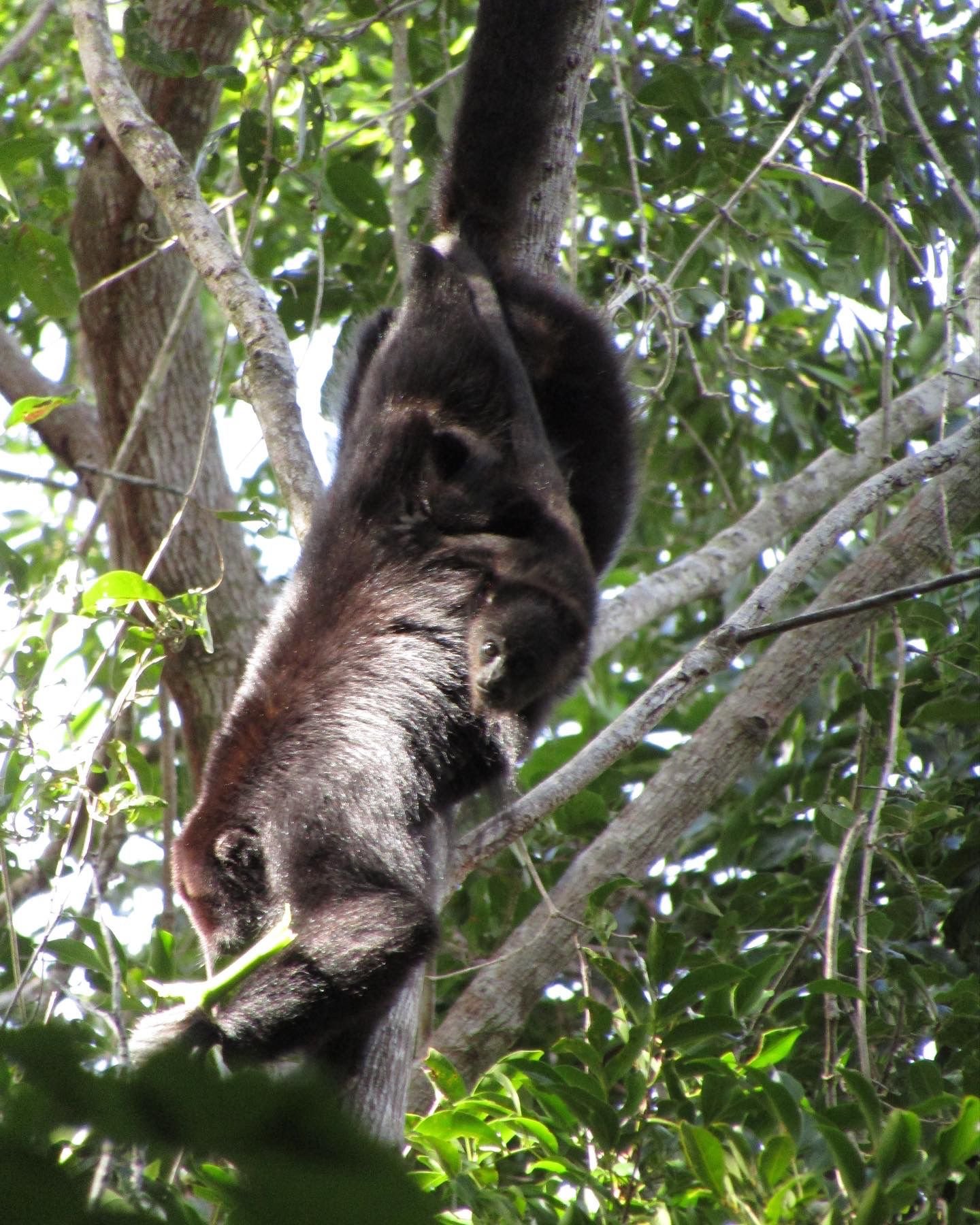Happy New Year!!
As we enter 2024, we have exciting news acoss all our programmes!
Our two rehab manatee calves, Tess and Toby, are approaching soft release – they will have their first days out in the soft release lagoon later this month / early next month. Before then they will be caught and ‘pit tagged’, so that that can be scanned and identified in the future, and fitted with soft release trackers that provide satellite data on where they go in the soft release lagoon. Also on the marine side, we are currently caring for two large turtles (a loggerhead and a green turtle), for the Belize Fisheries Department, as they recover from their injuries.
Injured green turtle being cared for for the Belize Fisheries Department
On the primate front, our Nursery Troop, Sprout and Meadow, are slowly transitioning to the Forest Enclosures – it may take them another month or so to permanently leave the Nursey, but they are enjoying their days spent playing in the larger Forest Enclosure. Rosie, the third Nursery monkey, has already moved out, and been adopted by Leah – a non-releasable adult who lost her sight after severe head trauma before rescue.
We have two pairs of howler monkeys in pre-release enclosures (Archie and Anerie, and Mowgli and Maisie) being prepared for release later this month in Fireburn / the Northeastern Biological Corridor. These will be followed by the four younger spider monkeys from Satellite Four – Cas, Kam, Ellie and Daisy. The 10-year assessment of release success for the Yucatan black howler monkeys is nearing its end - Wildtracks has released 86 howler monkeys into the Fireburn area, part of the North-Eastern Biological Corridor, between 2011 and 2023 through a carefully designed rehabilitation-reintroduction process. Over the ten-months of finding, tracking and collecting data on the released howler monkeys in the Northeast Biological Corridor, a total of 116 individual howler monkeys were identified within 21 troops that ranged in size from 1-10 individuals. 45.6% of the population were either juveniles or infants, and therefore born in Fireburn.
As we expand our capacity for taking non-target species (particularly coatis, raccoons, foxes and the occasional grison) we have been able to add forest enclosures and a pre-release enclosure to our Small Mammal Unit through Burgers’ Zoo.
2024 brings with it the construction of the replacement wildlife rehabilitation building, funded through grants from the Belize Fund for a Sustainable Future, Twycross Zoo and Burgers’ Zoo. To make way for the new building, we had to sweep out the old....and give thanks to all those who knew, worked in, loved (and hated) the old Manatee Building. To those who knew it as the Education building, those who filled the room with Walt Disney songs as they mixed manatee milk or chopped fruit (and those who were really irritated by those who sang Walt Disney songs), to those who danced to the songs and those who danced to their own beat....thank you for all the memories this building held! For those who will join us in the future, creating new memories...we look forward to your arrival!
Schematic for the new Wildtracks rehabilitation centre
Ongoing construction of the new building
As part of the End of the Year Appeal for equipping the building, all donations this month are going towards the Appeal. The building will require around US$10,000 to ensure it is fully equipped for operations - solar power installation, shelving, storage, animal care equipment...we are already US$6,200 towards our total – many thanks for all those who have donated!
On the Conservation Planning side, Wildtracks finalized the revision of Belize’s Wildlife Conservation and Management Act, in collaboration with the Belize Forest Department, and drafted Belize’s first Wildlife Policy. The revisions include a ban on circus animals and the use of animals for testing products, addresses cruelty to wildlife, management of exotic species and the recognition of the rights of indigenous peoples to manage wildlife within their lands. This still has to go through legal review and pass through Government, but it is a huge step forward!!
2023 in review
In other news, we congratulate our directors, Paul and Zoe Walker, who have both received MBEs as part of the King's New Year's Honours list this year, in recognition of their contribution to biodiversity and conservation in Belize! In their words… “We feel very honoured to be entrusted by the Government of Belize to provide rescue, rehabilitation and release services for some of its amazing wildlife, including endangered manatees, spider monkeys and howler monkeys. It has also been an inspiring adventure in the world of conservation planning across Belize's tropical forests, seas, and species....protected areas, conservation organizations and communities....and one that hasn't yet finished.
Whilst the awards have our names on them, they reflect the commitment of the Belize Government and the many conservation organizations and individuals we have collaborated with over the years, the work they do and the impacts they make. The awards also reflect the hard work and commitment of the volunteers and supporters who have made Wildtracks what it is today, and the greatly appreciated support from our local communities of Sarteneja and Fireburn.”















